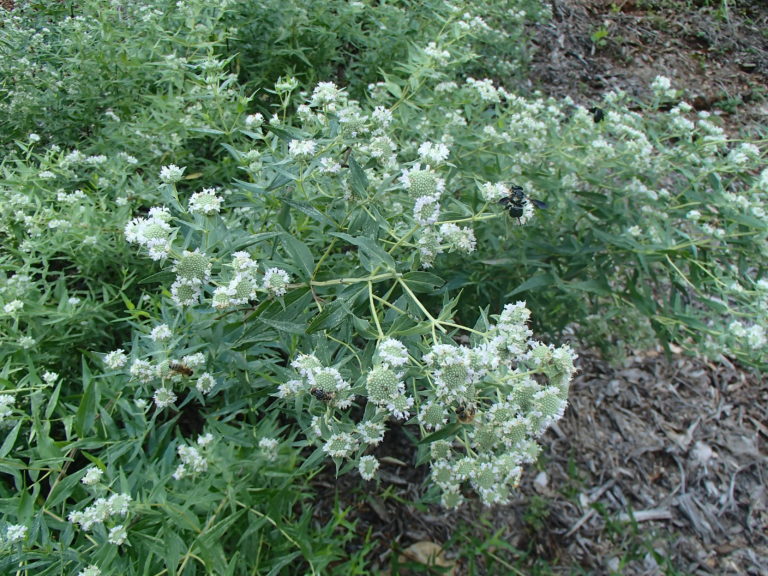Virginia Mountain Mint is an herbaceous perennial of the Mint family found mostly in north central and north eastern U.S. Two counties in NC are among a very small handful of counties reporting this plant in the southeast. Nevertheless, we are respectful of its potential value in our landscape for a number of reasons. It grows well here, in full sun/part shade with medium to moist soils; slender, branching stems support white-to-pale-lavender flowers at about 3′ in height which smell great and attract crowds of pollinators (bees, wasps, flies, small butterflies, beetles) during its very long bloom time from mid- to late-summer; it is a tough groundcover capable of holding a steep bank; and finally, like other members of this family, the narrow, opposite, simple leaves of Mountain Mint may be used in salads or to make tea. We have not found anything to dislike about this super-useful plant.
NURSERY HOURS
Wednesday: 10-4 Thursday: 10-6 Friday-Saturday: 10-4 Sunday: 12-4
Pycnanthemum virginianum

Key Info
Scientific Name: Pycnanthemum virginianum (L.) T. Dur. & B.D. Jacks. ex B.L. Rob. & Fernald
Common Names: Virginia Mountain Mint
Family Names: Lamiaceae (Mint) Family
Plant Type: Herbaceous perennial
Leaf Retention: Deciduous
Flower Color: White, sometimes with purple spots
Special Characteristics: Reported to be deer resistant., Leaves fragrant, Attracts butterflies, Food source (tea)
Additional Info
Habit: Erect, many branched, can be bushy; stems 4-angled with white hairs on the ridges (a diagnostic character); fibrous root system.
Height: 2' to 3'
Spread: 1.5' - 2'
Soil Conditions: Moist to medium, loam, sand, clay, or gravel soils
Leaves: Opposite, narrow, simple, tapering leaves up to 2½ inches long x up to ½ inch wide, sessile with smooth margins, releasing a srong mint scent when crushed.
Flowers (or reproductive structures: Flowers profuse; somewhat flat-topped, 3⁄4-inch, terminal clusters of up to 50 small, white, 2-lipped flowers which bloom from the outer edges inward over the course of about a month in midsummer.
Natural Distribution: Contrary to its common name, this plant does not usually occur in mountain habitats: rather, wet prairies, stream edges, moist bluffs.
USDA Hardiness Zone: 3 to 7
USDA Wetland Indicator Status in NC: FAC
Pollination: Bees, butterflies, other insects.
Wildlife Connections: Nectar-seeking insects attracted to Mountain Mint include various bees, wasps, flies, small butterflies, and beetles; is of special value to native bees, bumble bees, honey bees. Not attractive to mammalian herbivores.
Propagation: By seeds or by division in spring or by tip cuttings in early summer.
